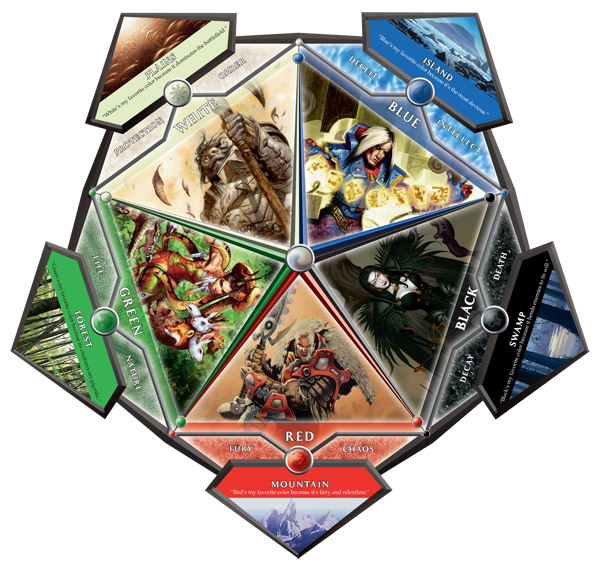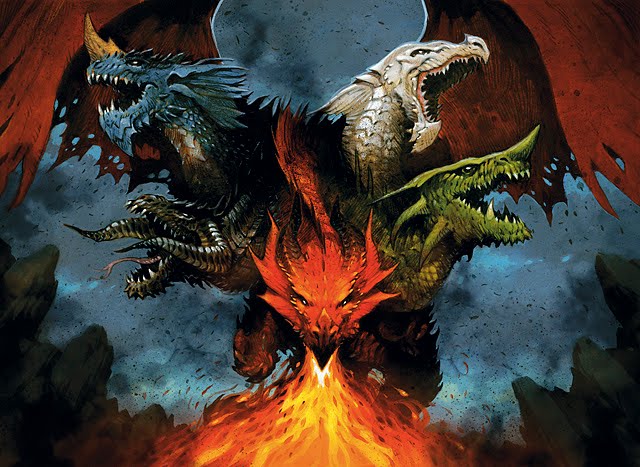Entries in mtg (1)
Easy hacks: re-flavoring chromatic dragons with the MTG color pie
 Wednesday, September 26, 2012 at 11:35PM
Wednesday, September 26, 2012 at 11:35PM Dragons are pretty great. I mean, who doesn’t like dragons? Tattoos, RPGs, bitching murals air-brushed on vans; it’s a flavor that goes pretty well with everything awesome. So why does the D&D take on dragons bum me out a little?
Simply put: they’re all too damn similar. Of the kinds most likely to end up in a monster manual, the metallic dragons are the worst offenders (explain the differences to me between a brass, copper, and bronze dragon; I dare you to keep me awake). The chromatics, while better, still leave some room for improvement. For my just-started 13th Age campaign, a few players chose The Three as a setting icon to include on their character sheet. The default 13th Age setting includes a Dragon Empire, which I’m keeping around both in name and function, and its Emperor is another of the icons that popped up on my players’ character sheets. Dragons are definitely going to be A Thing in this game!
The Three, as detailed in 13th Age, are the remainder of an original five archetypal dragons. The White was killed by another icon (the Lich King, back when he was just the Wizard King), and the Green is missing — possibly ransomed, possibly dead as well. The Red, Blue, and Black are still up and about, plotting their schemes and generally causing trouble. Of that trio, there’s some good separation. Perhaps wisely, authors Rob Heinsoo & Jonathan Tweet killed off the two chromatics that have been given short shrift in D&D.
But that doesn’t mean there aren’t lesser white and green dragons in the world. It simply means that those two iconic archetypes are now lost. And for the whole gang to fit together, there needs to be a cleaner philosophy explaining what makes a green dragon, or a white dragon, who it is. Plus, chromatic dragons as more-or-less irredeemable villains is boring. Yes, the metallics could be brought in, but as I said before, they’re in an even sorrier state. Working out my problem, I realized a possible answer lay in that other hobby that eats up all my time & money — Magic: the Gathering.
 One of the many things Magic has done exceptionally well in its almost 20-year history is define what separates its colors of mana. It’s smart game design and good business sense, too. There are mechanical, philosophical, and lore separations that make each of the five unique, so that each color has a recognizable style. And rather conveniently, its five colors are the same five colors of the most common chromatic dragons in D&D — I want that! So, let’s see how importing that system into the lore of chromatic dragons works out.
One of the many things Magic has done exceptionally well in its almost 20-year history is define what separates its colors of mana. It’s smart game design and good business sense, too. There are mechanical, philosophical, and lore separations that make each of the five unique, so that each color has a recognizable style. And rather conveniently, its five colors are the same five colors of the most common chromatic dragons in D&D — I want that! So, let’s see how importing that system into the lore of chromatic dragons works out.
For starters, in MTG, dragons as an actual creature type are tied pretty tightly to red; we won’t be including that, of course. Even so, we can use some artistic license to expand the category of “dragon” into something more broad and give each color dragon its own spin. Who says they only come in “St. George versus the Dragon” flavor? Broadening our idea of what a dragon can be can create some interest and unique setting elements to play around with in a campaign.
Magic includes one twist on the dragon concept right off the bat: the terrifyingly huge creatures for green mana aren’t traditional dragons, but “wurms” — burrowing monsters much like the sandworms from Dune. “Wurm” or “wyrm” has been a stand-in for dragons since medieval times, and the green type speak to some key dragon qualities: hunger, brute strength, titanic size. Green mana has associations of growth and nature, so let green dragons be heralded as bringers of these as well. And for the mechanical inner-workings, just borrow mechanics from D&D’s classic purple worm, stick some of them on a dragon, and now you have a working, land-bound dragon! Trying to satisfy expectations without being trapped by them opens up other dragons to shine, too. In this case, the other four colors shine a little brighter by virtue of their being able to fly, whereas the green can’t.
The other dearly departed dragon in 13th Age is the White. White mana, in Magic, is close to your typical good-guy archetype of the paladin variety: order, law, and selflessness. Mechanically, white cards in Magic often include life gain, bind other cards from acting, and support many smaller creatures working together. This “nice streak” sets our white dragon apart from his selfish, avaricious brethren in my eyes, so I want the eyes of player characters to see the difference too. I still want to keep traditional dragons on the scene, so we’ll leave The Three alone as far as looks. So what of the White?

A perfect opportunity to introduce a more Asiatic influence on dragonkind, I’d say. I love the look of the character Haku from the film Spirited Away, when he reveals his dragon form. Where are the wings, you ask? Is this kind flightless too? Not at all! When Haku flies, it just looks like this. There’s a poetry to that, and it just feels right for a white dragon. How would it work from a flavor perspective? Glad you asked!
Time to pull in some ideas from another favorite universe of mine to polish a few rough edges — Avatar: The Last Airbender. (I hope I don’t have to defend loving a kid’s show, because it’s one of the best animated shows around!) What I have a mind to steal is the idea that manipulating the element of “air” can allow someone to fly. I can see this working wonderfully for dragons. Call it something else in the setting, but if dragons can “bend” their given element, we also have a nice fit for our green dragons being land-bound — they’re tied to the earth element, of course.
Extending that idea, blue dragons get water and reds gets fire. Simple, and somewhat in line with the original Magic color wheel idea, too. Both can still fly, and look much as the 3.5 D&D Monster Manual depicts. As suggested by the setting details of 13th Age, the Blue dragon icon is a sorceress and her brood are masters of magic. The Red, I think, should be the one to stick closest to the medieval/Tolkien-esque dragon archetype: lusting for treasures, quick to anger, and woefully terrible in strength.
Where does this leave black? I have a couple ideas, and this is the one I’m running with in my home game: there’s a fifth element, as is often the case with “classic elements” outside of Greece. You see it in JRPGs all the time: “void”, “soul”, “spirit”; something like that. I think it can work great for black dragons with the right lore context. Combining the concepts of void and soul sounds a lot like the death bailiwick that black mana and black dragons are often connected to. Recast them as the bleak, baleful gate-keepers of the underworld, secluding themselves in places that fit their sullen temperament (like the swamps mentioned D&D’s monster manuals, and forgotten graveyards, too). Now they, too, have a place in the world that isn’t pure evil.
If you’ve gotten this far, but you’re not familiar with the MTG color wheel, here are some key concepts in each color:
- White: Order, civilization, law, light, healing, stubbornness
- Blue: Knowledge, intellect, time, ice, water, illusion, wizardry
- Black: Selfishness, death, decay, isolation, darkness, stealth
- Red: Passion, chaos, fire, quickness, recklessness, greed
- Green: Nature, growth, slowness, brute force, earth, life
Put that list to good use! This is just the sketch of an idea, understand. There are things I haven’t worked out yet (what is a black dragon’s breath weapon like? Was killing the White iconic dragon, with its healing association, a key to unlocking lichdom for the Wizard King? How does 13th Age’s metallic-seeming Great Gold Wyrm icon fit into all this?), but rather than me puzzle those things out and present this concept fully-realized, grab your own inspiration! From Magic: the Gathering or elsewhere, fill in those gaps in a way that makes sense. One facet of 13th Age that I really like it that it presents the bones of a setting, and invites player groups to flesh them out (this is one area where I think I sense the influence Eberron-creator Keith Baker, who’s thanked in the credits). As I continue to refine my world, I’ll share more places where I’ve molded outside inspiration into something that’s my own.
One last side note: my MTG concept has also led me to realize the remaining dragons in The Three make up a Grixis-shard trio… Just the thought of what that could mean for my players fills my heart with sadistic glee.



